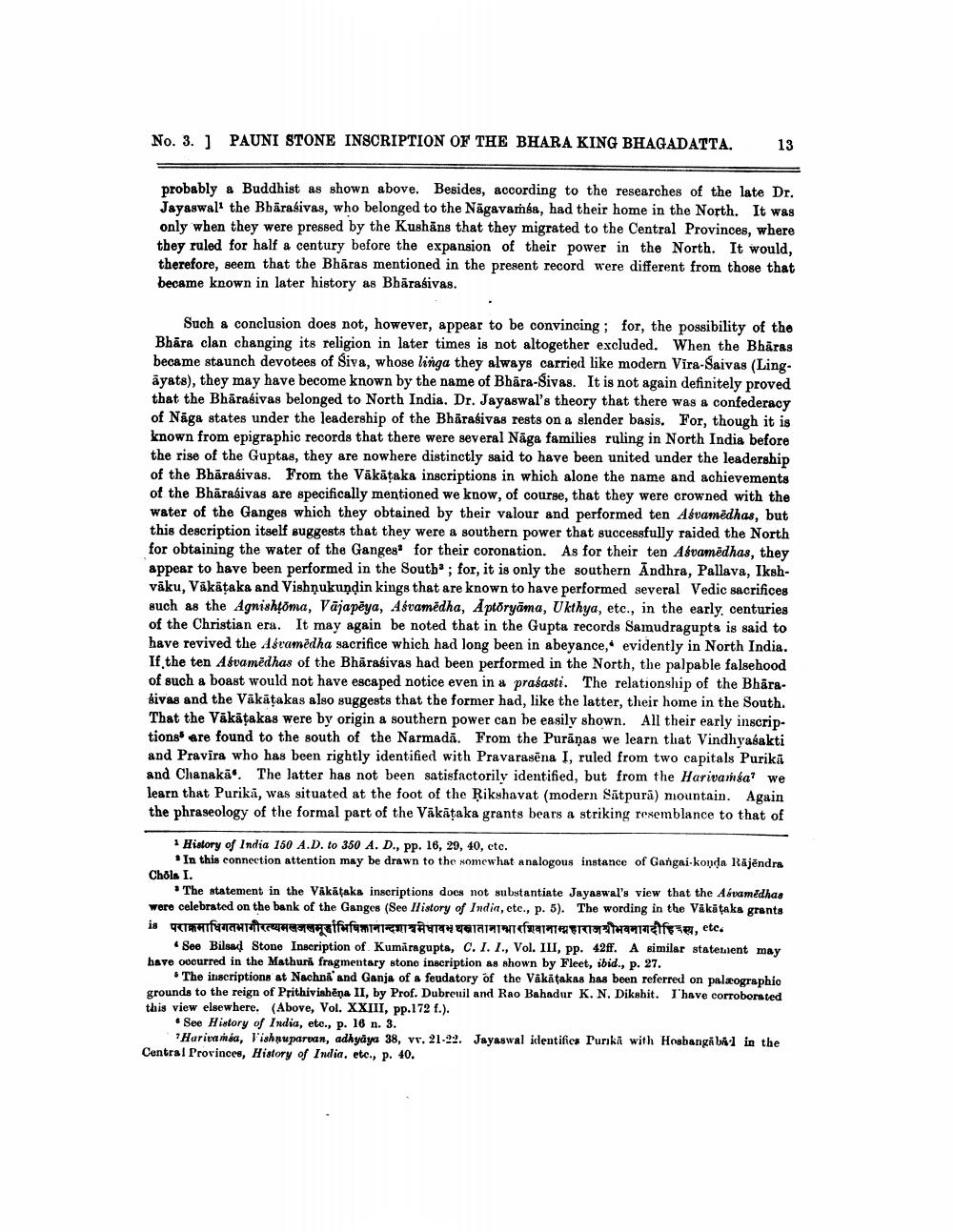________________
No. 3. 1 PAUNI STONE INSCRIPTION OF THE BHARA KING BHAGADATTA.
13
probably a Buddhist as shown above. Besides, according to the researches of the late Dr. Jayagwali the Bhārasivas, who belonged to the Nāgavamsa, had their home in the North. It was only when they were pressed by the Kushāns that they migrated to the Central Provinces, where they ruled for half a century before the expansion of their power in the North. It would, therefore, seem that the Bhāras mentioned in the present record were different from those that became known in later history as Bbärasivas.
Such a conclusion does not, however, appear to be convincing ; for, the possibility of the Bhāra clan changing its religion in later times is not altogether excluded. When the Bhāras became staunch devotees of Siva, whose linga they always carried like modern Vira-Saivas (Lingayats), they may have become known by the name of Bhāra-Sivas. It is not again definitely proved that the Bhārasivas belonged to North India. Dr. Jayaswal's theory that there was a confederacy of Nāga states under the leadership of the Bhārasivas rests on a slender basis. For, though it is known from epigraphic records that there were several Nāga families ruling in North India before the rise of the Guptas, they are nowhere distinctly said to have been united under the leadership of the Bhārasivas. From the Väkätaka inscriptions in which alone the name and achievements of the Bhärativas are specifically mentioned we know, of course, that they were crowned with the water of the Ganges which they obtained by their valour and performed ten Asvamēdhas, but this description itself suggests that they were a southern power that successfully raided the North for obtaining the water of the Ganges. for their coronation. As for their ten Afvamēdhas, they appear to have been performed in the South; for, it is only the southern Andhra, Pallava, Ikshvāku, Vákätaka and Vishnukundin kings that are known to have performed several Vedic sacrifices such as the Agnishtöma, Vājapeya, Asvamëdha, Aptoryāma, U kthya, etc., in the early. centuries of the Christian era. It may again be noted that in the Gupta records Samudragupta is said to have revived the Asramēdha sacrifice which had long been in abeyance, evidently in North India. If the ten Asvamëdhas of the Bhārasivas had been performed in the North, the palpable falsehood of such a boast would not have escaped notice even in a prasasti. The relationship of the Bharasivas and the Vākāțakas also suggests that the former had, like the latter, their home in the South. That the Vākāțakas were by origin a southern power can be easily shown. All their early inscriptions' ere found to the south of the Narmadā. From the Puranas we learn that Vindhyasakti and Pravira who has been rightly identified with Pravarasena I, ruled from two capitals Purikā and Chanaka. The latter has not been satisfactorily identified, but from the Harivansa? we learn that Purika, was situated at the foot of the Rikshavat (modern Sātpura) mountain. Again the phraseology of the formal part of the Vākātaka grants bears a striking resemblance to that of
1 History of India 150 A.D. to 350 A. D., pp. 16, 29, 40, etc.
* In this connection attention may be drawn to the somewhat analogous instance of Gangaikonda Rājēndra Chols I.
* The statement in the Vakataka inscriptions does not substantiate Jayaswal's view that the Advamedhas were celebrated on the bank of the Ganges (See llistory of India, etc., p. 5). The wording in the Vikātaka grants is f or effufamtia Teatatuf89177 Emm elfs e, etc.
See Bilsad Stone Inscription of Kumaragupta, c. I. I., Vol. III, pp. 42ff. A similar statement may have occurred in the Mathură fragmentary stone inscription as shown by Fleet, ibid., p. 27.
The inscriptions at Nachna and Ganja of a feudatory of the Vakatakas has been referred on palæographic grounds to the reign of Prithivishēņa II, by Prof. Dubreuil and Rao Bahadur K. N. Dikshit. I have corroborated this view elsewhere. (Above, Vol. XXIII, pp.172 f.).
. See History of India, etc., p. 16 n. 3.
Harimsa, Vishnuparuan, adhyāya 38, vr, 21-22. Jayaswal identific# Purika with Hosbanga il in the Central Provinces, History of India, etc., p. 40.




